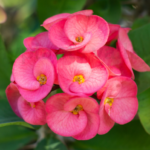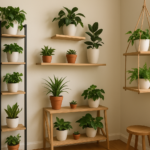Do you want to know how to care for a Mass Cane Plant? It is so easy. Just provide it with bright, indirect light and keep it moist but not waterlogged. Its tolerance for low light and infrequent watering makes it a great choice for beginners and those with busy lifestyles.
Here we’ll cover everything you need to know about growing and caring for a Mass Cane Plant, from choosing the right pot and soil to dealing with pests and diseases.
So whether you’re a seasoned plant parent or just starting, read how to give your Mass Cane Plant the best possible care.
Before we move on, let’s quickly go through some basic information that will set the stage for our exciting journey ahead.
| Common Name | Mass Cane Plant, Corn Plant |
| Scientific Name | Dracaena Massangeana |
| Family | Asparagaceae |
| Genus | Dracaena |
| Plant type | Flowering Plant |
| Native Habitat | Africa |
| USDA Hardiness Zone | 10- 11 |
| Light | Bright indirect light |
| Soil | Well-draining, Acidic, And neutral |
| Temperature | 60-75°F |
| Humidity | High |
| Water | Moderate |
| Fertilizer | Slow-release fertilizer |
| Pruning | Occasional |
| Repotting | Every two years |
| Toxic to Cats & Dogs | Yes |
| Toxic to Humans | Yes |
| Pests | Mealybugs, Aphids, Spider mites |
| Diseases | Root rot, Leaf Spot, Leaf Blight |
What Is A Mass Cane Plant?
The Mass Cane Plant, scientifically known as Dracaena Massangeana or Corn Plant, is a popular tropical houseplant with long, elegant leaves that resembles a palm tree.
It has a sturdy trunk with long, lanceolate leaves that grow upwards from the stem. The leaves are green with yellow stripes along the edges. A fully grown Mass Cane Plant can reach up to 6 feet tall.
The Mass Cane is a variety of the species Dracaena Fragrans. The original Dracaena have deep green leaves but the “Massangeana” variety has yellow bands through the center.
Origin Of Mass Cane Plant

The Mass Cane (Dracaena fragrans) Plant is native to tropical Africa, specifically from Angola to Mozambique, where it thrives in humid and hot conditions.
It was first introduced to Europe in the late 1800s and then made its way to the united states in the early 20th century. It belongs to the Asparagaceae family. Today, it is a common indoor plant found in homes and offices worldwide.
Unique Features Of Cane Plant
The Mass Cane plant, scientifically known as Dracaena Massangeana or corn plant, possesses several unique features that make it an appealing choice for indoor plant enthusiasts. Here are some of the distinctive characteristics of the Mass Cane plant:
Striking Foliage
One of the standout features of the Mass Cane plant is its eye-catching foliage. The leaves are long, lance-shaped, and feature vibrant green coloration with bold yellow stripes running along the center. This striking variegation adds a touch of tropical beauty to any indoor space.
Cane-Like Stems
As the plant matures, it develops thick, woody stems that resemble bamboo canes. These sturdy stems provide structural support to the plant and contribute to its unique appearance. They can grow upright and reach several feet high, creating an impressive vertical presence.
Mass Cane Flower

While not common in indoor settings, the Mass Cane plant can produce flowers under specific conditions. The flowers of the Mass Cane are small and usually pale yellow or cream in color. They are arranged in clusters on long stalks that emerge from the center of the rosette. The flowers have a pleasant fragrance. However, indoor-grown Mass Cane plants rarely bloom, requiring specific conditions, such as ample sunlight, warmth, and maturity, to initiate flowering.
Fruit

Following successful pollination of the Mass Cane flowers, the plant can produce fruit, although this is a relatively rare occurrence indoors. The fruit of the Mass Cane is a small, round berry-like structure that starts out green and transitions to a bright orange or red color as it ripens. Each fruit contains several seeds. While humans do not typically consume the fruit, it adds an intriguing and decorative element to the plant.
Popular Variants Of Mass Cane Plant
Several popular variants of the mass cane plant showcase slight differences in their leaves, stems, and overall appearance. These variants include:
- Dracaena fragrans ‘massangeana’ – the classic mass cane plant with green leaves and yellow stripes.
- Dracaena fragrans ‘Janet Craig’s – a variant with dark green leaves and a compact, sleek appearance.
- Dracaena fragrans ‘warneckii’ – a variegated variant with green and white striped leaves.
Mass Cane(Dracaena fragrans)Plant Care
Caring for a Mass Cane plant, also known as Dracaena Massangeana or the Corn Plant, involves providing the right conditions and attention to ensure its health and longevity. Here are some essential care guidelines to help you maintain a thriving Mass Cane plant:
1. Right Location And Light
The Mass Cane plant thrives in bright, indirect light. Place your Mass Cane Plant near a west or east-facing window that receives filtered sunlight or in a well-lit room where it can receive bright, indirect light. Avoid exposing it to direct sunlight, as it can scorch the leaves. A few hours of morning or late afternoon sun may be tolerated, but intense midday sun should be avoided.
It can tolerate lower light conditions, but too little light may result in slower growth and less vibrant foliage. Give your Mass Cane Plant a minimum of 4-6 hours of light per day.
2. Temperature
Maintaining suitable temperature levels is essential for the Mass Cane plant’s health and growth.
The Mass Cane plant thrives in average room temperatures ranging from 60-75°F (15-24°C). It appreciates temperatures that humans find comfortable, making it well-suited for indoor environments.
Protect the Mass Cane plant from extreme temperature fluctuations and drafts. Avoid placing it near heating or cooling vents, as sudden temperature changes can stress the plant.
Additionally, avoid exposing it to excessively hot or cold areas, such as near doors or windows during winter.
3. Watering the Mass Cane Plant
The Mass Cane Plant thrives in moist soil but it doesn’t tolerate over moisture.
First, check the soil moisture level by putting your finger into the soil. Water your Mass Cane plant thoroughly when the soil feels dry at the top.
Overwatering can lead to root rot, while underwatering can cause the leaves to turn brown and dry.
Water your Cane Plant during spring and summer when the plant is in an active growing mood and reduce watering during winter when the plant is in a dormant mood.
Ensure that the pot has proper drainage holes to allow excess water to escape. Waterlogged soil can lead to root rot and other issues.
4. Humidity
The Mass Cane plant can adapt to typical indoor humidity levels. However, it appreciates slightly higher humidity. You can increase humidity in many ways:
Humidifier: Using a humidifier is an effective and convenient method to maintain consistent humidity levels around the plant.
Pebble Tray: Fill a tray or saucer with water and place pebbles or stones in it. Set the potted Cane Plant on top of the pebbles, ensuring that the water doesn’t touch the pot’s bottom. It increases the humidity around the plant.
Misting: Regularly mist the leaves of the Mass Cane Plant using a spray bottle filled with room-temperature water. This helps to mimic the natural humid conditions it thrives in.
Grouping: Grouping plants together can create a microclimate of increased humidity due to the collective transpiration of the plants. Place the Mass plant near other houseplants to benefit from their combined humidity output.
5. Soil
The Mass Cane plant requires well-draining soil to prevent waterlogging and root rot. Use a well-draining potting mix that allows excess water to drain away.
A mix containing peat moss, perlite, and regular potting soil works well. Avoid using heavy or compacted soil that retains excessive moisture.
The Mass Cane plant prefers slightly acidic to neutral soil with a pH range of 6.0 to 7.0. A pH level outside this range can affect nutrient availability to the plant.
6. Pot Size And Drainage
Select a pot that is suitable for the current root ball of your Mass Cane plant. The pot should have enough room to accommodate the plant’s growth, but not be excessively large, as overly big pots can retain excess moisture, potentially leading to root rot.
Choose a pot with drainage holes at the bottom. These holes allow excess water to drain from the pool, preventing waterlogging and promoting healthy root growth.
You may also like Pink Panther Plant(Callisia Repens) care guide
7. Fertilizer
Use a balanced, water-soluble fertilizer specifically formulated for houseplants. Look for a fertilizer with an equal N-P-K (nitrogen-phosphorus-potassium) ratio or a ratio close to 1:1:1. This balanced formulation provides the necessary macronutrients for healthy growth.
Fertilize the Mass Cane plant during the growing season, typically in spring and summer. Generally, fertilizing once a month during the active growth period is sufficient. Reduce fertilization during winter months when the plant’s growth slows down.
Dilute the fertilizer according to the instructions provided on the packaging. Apply the diluted fertilizer to the soil around the base of the plant. Avoid direct contact with the leaves, as this can cause burning or damage.
If you prefer organic options, you can use slow-release organic fertilizers or compost. Apply these according to the product instructions or mix them into the potting soil during repotting.
8. Pruning Dracena Mass Cane
Pruning helps maintain the Mass Cane plant’s shape, remove damaged or diseased foliage, and encourage new growth. Consider the following guidelines for pruning:
Remove Dead or Yellowed Leaves: Regularly inspect your Mass Cane plant and remove any dead or yellowed leaves. Use clean, sharp pruning shears or scissors to make clean cuts near the base of the affected leaves. Removing these leaves helps maintain the plant’s appearance and prevents the spread of diseases.
Trim Brown Tips: If the leaf tips of your Mass Cane plant turn brown, you can trim them to improve its aesthetic appeal. Use clean, sharp scissors to make clean, angled cuts just above the browned area.
Controlling Height: Mass Cane plants can grow quite tall over time. If you prefer to control the plant’s height, you can trim the main stem at the desired height. This can encourage branching and create a bushier appearance. Prune just above a node (where a leaf emerges) to encourage new growth from that point.
Sanitization: Ensure your pruning tools are clean and sanitized. This helps prevent the spread of diseases or pests. Wipe the blades with rubbing alcohol or a disinfectant solution to keep them clean.
9. Repotting Mass Cane Plant
Repotting becomes necessary when your Mass Cane Plant outgrows its current pot or the soil becomes compacted. When repotting, follow these steps:
- Choose a new pot that is one size larger than the current pot, allowing for sufficient room for root growth.
- Gently remove the plant from its current pot, being careful not to damage the roots. If the roots are tightly packed, you can gently loosen them to encourage outward growth.
- Place fresh soil in the new pot and create a small mound in the center. Position the Hoya Sunrise on top of the mound, spreading the roots outward.
- Fill the remaining space with soil, ensuring that the plant is at the same level as before. Lightly press the soil around the plant to secure it.
- Water the newly repotted plant thoroughly to settle the soil and promote root establishment.
Tips: Remember to monitor the plant closely after repotting to ensure it adapts well to its new container. Adjust your watering routine as needed, and provide appropriate care based on the specific requirements of your Mass Cane Plant.
Propagating Mass Cane Plant
If you want more Mass Cane Plants (also known as corn plants) around your home, you have two main options – propagating from cuttings or division. Whether you want to fill out your garden or share it with friends, these methods are cost-effective and easy.
Propagation Methods
Mass Cane Plant propagation is creating new plants by using existing ones. Propagation helps grow new plants that can be used for decoration or gifting.
Here are two main methods of propagation:
Starting Mass Cane Plant From Cuttings
Cuttings are the easiest method of propagation. Here’s how:
- Select a healthy Mass Cane Plant and get a sharp, sterile pair of scissors or pruners.
- Cut a healthy stem from the plant, ensuring it is at least 3 inches long, and remove any leaves from the bottom of the cutting.
- Dip the cutting in the rooting hormone. It will help the plant root more quickly.
- Plant the cutting in a container filled with well-draining soil.
- Water the cutting and place it in bright, indirect sunlight.
- Keep the soil moist and ensure the plant has proper drainage.
- Wait for roots to form, which usually takes around six weeks.
- Once the plant has established itself, transplant it into a bigger container.
Starting Mass Cane Plant From Division
Another method of propagating Mass Cane Plants is division. This method works well if your plant has outgrown its container or if you want to share the Mass Cane Plant with others. Here’s how:
- Remove the plant from its container so it can be inspected. Be careful not to damage the roots during this process.
- Look for natural breaks in the plant clump and use your hands to separate sections from the main plant.
- Remove dead roots and soil from the root ball, repot the divided plant, and water it well.
- Place the plant in a well-lit area but away from direct sunlight. Keep the soil moist for the first few weeks.
- Be sure to fertilize as normal.
Common Leaf Issues Of Mass Cane Plant
The Mass Cane plant, also known as Dracaena Massangeana or corn plant, is a popular indoor plant known for its attractive foliage and low-maintenance requirements. However, like any other houseplant, it can encounter various leaf issues that may affect its overall health and appearance.
Brown Tips
One of the most common leaf problems in Mass Cane plants is the browning of leaf tips. This can occur due to several reasons, including overwatering, underwatering, or exposure to dry air. To address this issue, ensure that you water the plant appropriately, allowing the top inch of soil to dry out between waterings. Also, provide adequate humidity.
Yellowing leaves
Yellowing leaves can be indicative of either overwatering or underwatering. Adjust your watering routine accordingly, making sure to strike a balance and avoid extremes.
Leaf spots
If you notice brown or yellow spots on the leaves of your Mass Cane plant, it could be due to fungal or bacterial infections. Leaf spots are often caused by overwatering, poor air circulation, or high humidity. To prevent and treat this issue, avoid overhead watering, provide good ventilation, and ensure the plant is not crowded with other plants.
Leaf drop
Leaf Drops can occur due to changes in light conditions, temperature fluctuations, or stress from relocation. To minimize leaf drop in Mass Cane plants, maintain a consistent care routine that includes appropriate watering, adequate light, and a suitable environment.
Stunted growth
Slow or stunted growth in a Mass Cane plant can be caused by insufficient light, inadequate nutrients, or overly compacted root systems. Ensure that your plant is receiving sufficient indirect light. Fertilize the plant regularly with a balanced houseplant fertilizer. If the plant becomes root-bound, consider repotting it into a larger container to promote healthier growth.
Pests And Diseases of Mass Cane Plant
Mass Cane Plant is generally a resilient plant, but like any other houseplant, it can be susceptible to certain pests and diseases.
Here are some common pests and diseases that may affect the Mass Cane Plant.
Pests
1. Aphids: Aphids are small, soft-bodied insects that can gather new growth, causing curling and distortion. They can be found clustered on new growth, undersides of leaves, or along stems.
Use a strong stream of water to wash off aphids from the plant. Alternatively, you can apply insecticidal soap or neem oil following the product instructions. Repeat treatments may be necessary to fully eliminate the infestation.
2. Spider Mites: Spider mites are tiny pests that can cause webbing on the leaves and damage the plant by piercing the cells and sucking out the sap.
Regularly misting the leaves to increase humidity can help deter spider mites. If an infestation occurs, you can use insecticidal soap, neem oil, or horticultural oil following the product instructions. Ensure thorough coverage, targeting the undersides of leaves.
3. Mealybugs: Mealybugs are small, cotton-like insects that gather in clusters. They can be found on leaf joints, leaf undersides, and along stems. Infested areas may appear white or have a sticky residue.
Remove mealybugs manually using a cotton swab dipped in rubbing alcohol or soapy water. For severe infestations, you can use insecticidal soap or neem oil following the product instructions.
Diseases
Here is a common list of diseases that yourMass Cane Plant can be afflicted with.
Leaf Spot
Leaf spot diseases are fungal or bacterial infections that cause spots or lesions on the leaves. The areas may vary in color, including brown, black, or yellow, and can sometimes have a concentric ring pattern.
Remove and destroy any infected leaves to prevent the spread of the disease. Ensure proper air circulation and avoid over-watering to minimize moisture on the foliage. Applying a fungicide or bactericide following the product instructions can help manage severe cases.
Root Rot
Root rot is caused by overwatering or poorly draining soil, leading to the decay of the plant’s roots. Symptoms include wilting, yellowing leaves, and a foul odor from the soil.
Address root rot by improving drainage conditions. Allow the soil to dry out slightly between waterings and ensure the pot has adequate drainage holes. Trim any affected roots and repot the plant using fresh, well-draining soil.
Leaf Blight
Leaf blight is a fungal disease that causes large brown or black spots on the leaves. Remove affected leaves and ensure proper air circulation and soil drainage. Apply a fungicide if the blight persists.
By staying vigilant and taking prompt action when necessary, you can effectively manage and mitigate pest and disease issues in your beloved Mass Cane Plant, ensuring its health and vibrancy.
FAQs
How do you keep a Mass Cane plant alive?
To keep a Mass Cane plant alive, provide it with bright, indirect light. Water it thoroughly when the top inch of the soil feels dry, ensuring proper drainage. Maintain moderate humidity levels and avoid overwatering or underwatering. Regularly dust the leaves and prune any yellowing or dead foliage.
Why is my Mass Cane plant turning brown?
Mass Cane plants can turn brown due to overwatering, underwatering, excessive direct sunlight, or low humidity levels. Assess your watering routine, adjust light exposure, increase humidity, and ensure the plant is not experiencing temperature extremes.
Is Mass Cane a good plant?
Yes, Mass Cane (Dracaena massangeana) is a popular and attractive indoor plant. It features vibrant green foliage and is known for its resilience and low-maintenance nature. It can thrive in various indoor environments, making it a good choice for plant enthusiasts of all experience levels.
How do you take care of a Mass Cane plant?
To care for a Mass Cane plant, place it in bright, indirect light. Water when the top inch of soil is dry, and ensure proper drainage. Maintain moderate humidity levels, dust the leaves regularly, and prune any yellow or dead foliage. Fertilize occasionally during the growing season.
Is Mass Cane a house plant?
Yes, Mass Cane is commonly grown as a houseplant due to its adaptability to indoor conditions.
Where to buy a Mass Cane plant?
Mass Cane plants can be purchased from local nurseries, garden centers, or online plant retailers. Check with your nearest plant stores or explore reputable online platforms that offer a wide selection of indoor plants.
Why are my Mass Cane leaves turning brown?
Mass Cane leaves can turn brown due to overwatering, underwatering, excessive direct sunlight, low humidity, or pest infestation. Evaluate your care routine, adjust watering and light conditions, increase humidity, and inspect the plant for any signs of pests.
What are the Mass Cane plant benefits?
Mass Cane plants are not only aesthetically pleasing but also offer several benefits. They can help improve indoor air quality by filtering out toxins and pollutants. Additionally, their presence can create a calming and inviting ambiance, contributing to overall well-being and stress reduction.
Is the Mass Cane plant toxic?
Yes, Mass Cane (Dracaena massangeana) is toxic to cats, dogs, and other pets if ingested. It contains compounds that can cause digestive discomfort and other health issues. Keep the plant out of reach of pets and children to ensure their safety.
How to save a dying Mass Cane plant?
To save a dying Mass Cane plant, assess the possible causes such as overwatering, underwatering, light issues, or pests. Adjust watering practices, provide appropriate light conditions, increase humidity, and address any pest problems. Trim away any severely damaged or yellowed foliage and provide optimal care to help the plant recover.
What is another name for the Mass Cane plant?
The Mass Cane plant is also commonly referred to as the corn plant or Dracaena corn plant due to its resemblance to the leaves of corn plants. These names are used for the same species, Dracaena Massangeana.
How long does the Mass Cane plant live?
With proper care, a Mass Cane plant can live for several years. On average, they have a lifespan of 5 to 10 years, but some well-maintained plants can thrive even longer.
Conclusion
After reading how to care for Mass Cane Plants, you should better understand how to keep them thriving in your home or office. Remember to place the plant in bright, indirect light and water it thoroughly but infrequently.
Monitor for signs of pests or diseases and address them promptly. Pruning and repotting can be done as needed.
The mass cane plant is a beautiful and low-maintenance addition to any space. With the proper care and attention, your mass cane plants can grow tall and healthy for many years. Happy green thumb!







